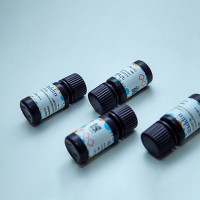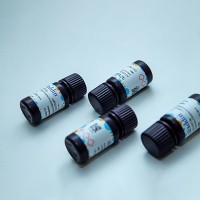RNA Structure Analysis of Viruses Using SHAPE
互联网
- Abstract
- Table of Contents
- Materials
- Literature Cited
Abstract
Selective 2? hydroxyl acylation analyzed by primer extension (SHAPE) provides a means to investigate RNA structure with better resolution and higher throughput than has been possible with traditional methods. We present several protocols, which are based on a variety of previously published methods and were adapted and optimized for the analysis of poliovirus RNA in the Andino laboratory. These include methods for nondenaturing RNA extraction, RNA modification and primer extension, and data processing in ShapeFinder. Curr. Protoc. Microbiol . 30:15H.3.1?15H.3.12. © 2013 by John Wiley & Sons, Inc.
Keywords: RNA structure; selective 2? hydroxyl acylation; primer extension; SHAPE
Table of Contents
- Introduction
- Basic Protocol 1: Nondenaturing RNA Extraction
- Basic Protocol 2: Selective 2′ Hydroxy Acylation Analyzed by Primer Extension (SHAPE)
- Alternate Protocol 1: Folding and Modification of In Vitro Transcribed RNA
- Basic Protocol 3: Processing and Analysis of SHAPE Data
- Reagents and Solutions
- Commentary
- Literature Cited
- Tables
Materials
Basic Protocol 1: Nondenaturing RNA Extraction
Materials
Basic Protocol 2: Selective 2′ Hydroxy Acylation Analyzed by Primer Extension (SHAPE)
Materials
Alternate Protocol 1: Folding and Modification of In Vitro Transcribed RNA
Materials
|
Figures
Videos
Literature Cited
| Literature Cited | |
| Aviran, S., Trapnell, C., Lucks, J.B., Mortimer, S.A., Luo, S., Schroth, G.P., Doudna, J.A., Arkin, A.P., and Pachter, L. 2011. Modeling and automation of sequencing‐based characterization of RNA structure. Proc. Natl. Acad. Sci. U.S.A. 108:11069‐11074. | |
| Deigan, K.E., Li, T.W., Mathews, D.H., and Weeks, K.M. 2009. Accurate SHAPE‐directed RNA structure determination. Proc. Natl. Acad. Sci. U.S.A. 106:97‐102. | |
| Ehresmann, C., Baudin, F., Mougel, M., Romby, P., Ebel, J.P., and Ehresmann, B. 1987. Probing the structure of RNAs in solution. Nucleic Acids Res. 15:9109‐9128. | |
| Kertesz, M., Wan, Y., Mazor, E., Rinn, J.L., Nutter, R.C., Chang, H.Y., and Segal, E. 2010. Genome‐wide measurement of RNA secondary structure in yeast. Nature 467:103‐107. | |
| Laing, C. and Schlick, T. 2011. Computational approaches to RNA structure prediction, analysis, and design. Curr. Opin. Struct. Biol. 21:306‐318. | |
| Low, J.T. and Weeks, K.M. 2010. SHAPE‐directed RNA secondary structure prediction. Methods 52:150‐158. | |
| Lucks, J.B., Mortimer, S.A., Trapnell, C., Luo, S., Aviran, S., Schroth, G.P., Pachter, L., Doudna, J.A., and Arkin, A.P. 2011. Multiplexed RNA structure characterization with selective 2′‐hydroxyl acylation analyzed by primer extension sequencing (SHAPE‐Seq). Proc. Natl. Acad. Sci. U.S.A. 108:11063‐11068. | |
| Mathews, D.H., Moss, W.N., and Turner, D.H. 2010. Folding and finding RNA secondary structure. Cold Spring Harb. Perspect. Biol. 2:a003665. | |
| McGinnis, J.L., Duncan, C.D., and Weeks, K.M. 2009. High‐throughput SHAPE and hydroxyl radical analysis of RNA structure and ribonucleoprotein assembly. Methods Enzymol. 468:67‐89. | |
| Merino, E.J., Wilkinson, K.A., Coughlan, J.L., and Weeks, K.M. 2005. RNA structure analysis at single nucleotide resolution by selective 2′‐hydroxyl acylation and primer extension (SHAPE). J. Am. Chem. Soc. 127:4223‐4231. | |
| Peattie, D.A. and Gilbert, W. 1980. Chemical probes for higher‐order structure in RNA. Proc. Natl. Acad. Sci. U.S.A. 77:4679‐4682. | |
| Regulski, E.E. and Breaker, R.R. 2008. In‐line probing analysis of riboswitches. Methods Mol. Biol. 419:53‐67. | |
| Reuter, J.S. and Mathews, D.H. 2010. RNAstructure: Software for RNA secondary structure prediction and analysis. BMC Bioinformatics 11:129. | |
| Rivas, E. and Eddy, S.R. 2000. The language of RNA: A formal grammar that includes pseudoknots. Bioinformatics 16:334‐340. | |
| Smith, A. and Nelson, R.J. 2004. Capillary electrophoresis of DNA. Curr. Protoc. Mol. Biol. 68:2.8.1‐2.8.17. | |
| Stern, S., Moazed, D., and Noller, H.F. 1988. Structural analysis of RNA using chemical and enzymatic probing monitored by primer extension. Methods Enzymol. 164:481‐489. | |
| Tijerina, P., Mohr, S., and Russell, R. 2007. DMS footprinting of structured RNAs and RNA‐protein complexes. Nat. Protoc. 2:2608‐2623. | |
| Vasa, S.M., Guex, N., Wilkinson, K.A., Weeks, K.M., and Giddings, M.C. 2008. ShapeFinder: A software system for high‐throughput quantitative analysis of nucleic acid reactivity information resolved by capillary electrophoresis. RNA 14:1979‐1990. | |
| Watts, J.M., Dang, K.K., Gorelick, R.J., Leonard, C.W., Bess, J.W. Jr., Swanstrom, R., Burch, C.L., and Weeks, K.M. 2009. Architecture and secondary structure of an entire HIV‐1 RNA genome. Nature 460:711‐716. | |
| Weeks, K.M. 2010. Advances in RNA structure analysis by chemical probing. Curr. Opin. Struct. Biol. 20:295‐304. | |
| Wiebe, N.J. and Meyer, I.M. 2010. TRANSAT―method for detecting the conserved helices of functional RNA structures, including transient, pseudo‐knotted and alternative structures. PLoS Comput. Biol. 6:e100823. | |
| Wilkinson, K.A., Merino, E.J., and Weeks, K.M. 2006. Selective 2′‐hydroxyl acylation analyzed by primer extension (SHAPE): Quantitative RNA structure analysis at single nucleotide resolution. Nat. Protoc. 1:1610‐1616. | |
| Wilkinson, K.A., Vasa, S.M., Deigan, K.E., Mortimer, S.A., Giddings, M.C., and Weeks, K.M. 2009. Influence of nucleotide identity on ribose 2′‐hydroxyl reactivity in RNA. RNA 15:1314‐1321. |







